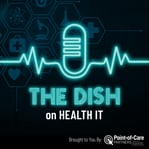Listen and Subscribe to Our Podcast
"The Dish on Health IT"
Engaging discussion around Health IT with perspectives from across the healthcare landscape. This informative and entertaining rotating panel of senior health IT consultants and their guests will keep you in the know about the latest innovations, policies and industry shifts impacting healthcare and point out the opportunities that lie within.

Subscribe on:
Apple Podcasts
Google Podcasts
Part 1, Episode 4: HIEs Now & Future
Guest, Dr. Tim Pletcher, Executive Director of the Michigan Health Information Network Shared Services (MiHIN)joins The Dish on Health IT panel of senior consultants, Gary Austin, Jocelyn Keegan and Ken Kleinberg to discuss the role of Health Information Exchanges in healthcare, their role in the response to COVID-19 and what role they can serve in the future once TEFCA is finalized.
Gary Austin kicked off the episode by having Ken and Jocelyn give their perspective on HIEs. Ken went on to provide a primer on the history of HIEs and their varying role depending on the model before going on to mention that the Trusted Exchange Framework and Common Agreement (TEFCA) may change the ecosystem once finalized.
Dr. Pletcher explained that the MiHIN Group is comprised of 3 companies: MiHIN, Velatura & Interoperability Institute. Each company serves a specific purpose. Velatura was created to stay aware of what is happening at the national level and to operate nationally. The Interoperability Institute is a research and development group staffed by interns who are the next generation of Health IT professionals.
HIEs were compared to public commons, like parks and good roads and bridges that people want to have but don't necessarily want to pay for. Dr. Pletcher pointed out that many HIEs were created prematurely before EHR standards and adoption was where it needed to be for valuable data exchange.
Ultimately the value model for MiHIN is based on use cases that are then driven to mass adoption. The value lies primarily with the government and health insurance companies so payers primarily pay for MiHIN service so providers are incentivized to improve data quality while being subsidized to change their workflow to do so.
What's the difference between the successful HIE vs struggling models? Dr. Pletcher pointed out that it's centered around the value the HIE is bringing to each stakeholder and building upon it over time while following the money.
Jocelyn added that solving real problems and talking about the elephants in the room to deal with barriers head-on is crucial. She offered that having MiHIN join the HL7 Da Vinci Project is hastening progress. There is an opportunity for HIEs to reinvent themselves as more flexible API standards are developed and take advantage of fielded codifiable exchange tools to get things into real production environments and take out custom codes and massive production efforts.
The team continued to discuss the financial model of HIEs and how they may evolve post-COVID-19. Will there be more government funding after COVID-19 calms down? Maybe, but there are a lot of people in need and the general funds at the state level are tapped. There may be some federal programs that look toward automation to cut down on some of he manual processes that are still eating up resources. There may be other non-government revenue streams that open up either with employers or by offering telehealth services at the HIE level.
Jocelyn pointed out that while streamlining and making data liquid in general (whether through HIEs or just better adoption of APIs in general) is a money saver for health systems and payers, patients also win through getting better, more informed care and ultimately leading to better outcomes.
Part 2 of this conversation is coming soon!




